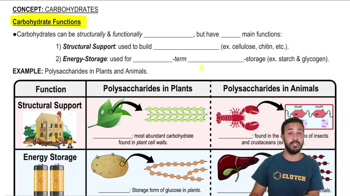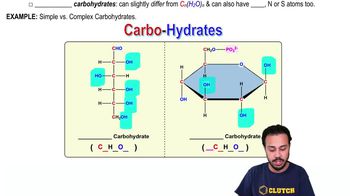Table of contents
- 1. Introduction to Biology2h 42m
- 2. Chemistry3h 40m
- 3. Water1h 26m
- 4. Biomolecules2h 23m
- 5. Cell Components2h 26m
- 6. The Membrane2h 31m
- 7. Energy and Metabolism2h 0m
- 8. Respiration2h 40m
- 9. Photosynthesis2h 49m
- 10. Cell Signaling59m
- 11. Cell Division2h 47m
- 12. Meiosis2h 0m
- 13. Mendelian Genetics4h 44m
- Introduction to Mendel's Experiments7m
- Genotype vs. Phenotype17m
- Punnett Squares13m
- Mendel's Experiments26m
- Mendel's Laws18m
- Monohybrid Crosses19m
- Test Crosses14m
- Dihybrid Crosses20m
- Punnett Square Probability26m
- Incomplete Dominance vs. Codominance20m
- Epistasis7m
- Non-Mendelian Genetics12m
- Pedigrees6m
- Autosomal Inheritance21m
- Sex-Linked Inheritance43m
- X-Inactivation9m
- 14. DNA Synthesis2h 27m
- 15. Gene Expression3h 20m
- 16. Regulation of Expression3h 31m
- Introduction to Regulation of Gene Expression13m
- Prokaryotic Gene Regulation via Operons27m
- The Lac Operon21m
- Glucose's Impact on Lac Operon25m
- The Trp Operon20m
- Review of the Lac Operon & Trp Operon11m
- Introduction to Eukaryotic Gene Regulation9m
- Eukaryotic Chromatin Modifications16m
- Eukaryotic Transcriptional Control22m
- Eukaryotic Post-Transcriptional Regulation28m
- Eukaryotic Post-Translational Regulation13m
- 17. Viruses37m
- 18. Biotechnology2h 58m
- 19. Genomics17m
- 20. Development1h 5m
- 21. Evolution3h 1m
- 22. Evolution of Populations3h 52m
- 23. Speciation1h 37m
- 24. History of Life on Earth2h 6m
- 25. Phylogeny2h 31m
- 26. Prokaryotes4h 59m
- 27. Protists1h 12m
- 28. Plants1h 22m
- 29. Fungi36m
- 30. Overview of Animals34m
- 31. Invertebrates1h 2m
- 32. Vertebrates50m
- 33. Plant Anatomy1h 3m
- 34. Vascular Plant Transport1h 2m
- 35. Soil37m
- 36. Plant Reproduction47m
- 37. Plant Sensation and Response1h 9m
- 38. Animal Form and Function1h 19m
- 39. Digestive System1h 10m
- 40. Circulatory System1h 57m
- 41. Immune System1h 12m
- 42. Osmoregulation and Excretion50m
- 43. Endocrine System1h 4m
- 44. Animal Reproduction1h 2m
- 45. Nervous System1h 55m
- 46. Sensory Systems46m
- 47. Muscle Systems23m
- 48. Ecology3h 11m
- Introduction to Ecology20m
- Biogeography14m
- Earth's Climate Patterns50m
- Introduction to Terrestrial Biomes10m
- Terrestrial Biomes: Near Equator13m
- Terrestrial Biomes: Temperate Regions10m
- Terrestrial Biomes: Northern Regions15m
- Introduction to Aquatic Biomes27m
- Freshwater Aquatic Biomes14m
- Marine Aquatic Biomes13m
- 49. Animal Behavior28m
- 50. Population Ecology3h 41m
- Introduction to Population Ecology28m
- Population Sampling Methods23m
- Life History12m
- Population Demography17m
- Factors Limiting Population Growth14m
- Introduction to Population Growth Models22m
- Linear Population Growth6m
- Exponential Population Growth29m
- Logistic Population Growth32m
- r/K Selection10m
- The Human Population22m
- 51. Community Ecology2h 46m
- Introduction to Community Ecology2m
- Introduction to Community Interactions9m
- Community Interactions: Competition (-/-)38m
- Community Interactions: Exploitation (+/-)23m
- Community Interactions: Mutualism (+/+) & Commensalism (+/0)9m
- Community Structure35m
- Community Dynamics26m
- Geographic Impact on Communities21m
- 52. Ecosystems2h 36m
- 53. Conservation Biology24m
4. Biomolecules
Carbohydrates
Problem 4`
Textbook Question
What are the primary functions of carbohydrates in cells?
a. Cell identity, energy storage, raw material source for synthesis, and structure
b. Catalysis, energy storage, metabolism, and structure
c. Catalysis, digestion, energy storage, and information storage
d. Energy storage, information storage, polymerization, and raw material source for synthesis
 Verified step by step guidance
Verified step by step guidance1
Understand that carbohydrates are organic molecules composed of carbon, hydrogen, and oxygen, typically in a ratio of 1:2:1.
Recognize that one of the primary functions of carbohydrates is energy storage. They are stored as glycogen in animals and starch in plants.
Identify that carbohydrates serve as a raw material source for the synthesis of other molecules. They can be converted into amino acids and fatty acids.
Acknowledge that carbohydrates play a role in cell identity. Glycoproteins and glycolipids on cell surfaces are involved in cell recognition and signaling.
Note that carbohydrates contribute to structural components in cells. For example, cellulose in plant cell walls provides structural support.
 Verified video answer for a similar problem:
Verified video answer for a similar problem:This video solution was recommended by our tutors as helpful for the problem above
Video duration:
1mPlay a video:
Was this helpful?
Key Concepts
Here are the essential concepts you must grasp in order to answer the question correctly.
Carbohydrates in Energy Storage
Carbohydrates are crucial for energy storage in cells, primarily in the form of glycogen in animals and starch in plants. These polysaccharides can be broken down into glucose, which is used in cellular respiration to produce ATP, the energy currency of the cell. This process is vital for maintaining cellular functions and supporting metabolic activities.
Recommended video:
Guided course

Carbohydrate Functions
Carbohydrates as Raw Material for Synthesis
Carbohydrates serve as raw materials for the synthesis of other biomolecules. Monosaccharides like glucose can be converted into various compounds, including nucleotides and amino acids, through metabolic pathways. This versatility makes carbohydrates essential for building complex molecules necessary for cell growth and repair.
Recommended video:
Guided course

Carbohydrates
Carbohydrates in Cell Structure
Carbohydrates contribute to cell structure, particularly in the form of cellulose in plant cell walls and chitin in fungal cell walls and arthropod exoskeletons. These polysaccharides provide rigidity and protection, helping maintain cell shape and integrity. Structural carbohydrates are crucial for the physical support and defense of cells.
Recommended video:
Guided course

Carbohydrates
Related Videos
Related Practice














